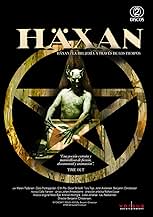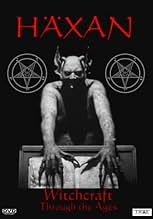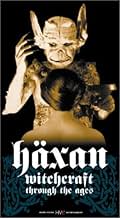CALIFICACIÓN DE IMDb
7.6/10
18 k
TU CALIFICACIÓN
Documental dramatizado que retrata la evolución de la brujería, de sus raíces paganas a su confusión con la histeria en la Europa de la modernidad.Documental dramatizado que retrata la evolución de la brujería, de sus raíces paganas a su confusión con la histeria en la Europa de la modernidad.Documental dramatizado que retrata la evolución de la brujería, de sus raíces paganas a su confusión con la histeria en la Europa de la modernidad.
- Dirección
- Guionista
- Elenco
Elisabeth Christensen
- En ældre bondekone
- (as Elizabeth Christensen)
- …
John Andersen
- Chief Inquisitor
- (as Johs Andersen)
Emmy Schønfeld
- Marie, the Seamstress
- (as Emmy Schönfeld)
- Dirección
- Guionista
- Todo el elenco y el equipo
- Producción, taquilla y más en IMDbPro
Opiniones destacadas
The writer and director Benjamin Christensen discloses a historical view of the witches through the seven parts of this silent movie.
In the beginning, there is a slide-show alternating intertitles with drawings and paintings to illustrate the explanations of the behavior of pagan cultures and in the Middle Ages regarding their vision of demons and witches.
Then there is a dramatization of the situation of the witches in the Middle Ages, with the witchcraft and the witch-hunts.
Finally Benjamin Christensen compares the behavior of hysteria of the modern women of 1921 with the behavior of the witches in the Middle Ages, concluding that they are very similar.
"Häxan" is incredibly perfect for a for a 1922 movie. Like in a thesis, he exposes his point of view based in his study of the theme along the time. The reconstitution of the witches in the Middle Ages is amazing. The last part with the comparison with the hysteric women is funny in 2010, but it was the reality in 1921. My vote is eight.
Title (Brazil): "Häxan - A Feitiçaria Através dos Tempos" ("Häxan - The Witchcraft Through the Time")
Note: On 16 Aug 2018 I saw this film again.
In the beginning, there is a slide-show alternating intertitles with drawings and paintings to illustrate the explanations of the behavior of pagan cultures and in the Middle Ages regarding their vision of demons and witches.
Then there is a dramatization of the situation of the witches in the Middle Ages, with the witchcraft and the witch-hunts.
Finally Benjamin Christensen compares the behavior of hysteria of the modern women of 1921 with the behavior of the witches in the Middle Ages, concluding that they are very similar.
"Häxan" is incredibly perfect for a for a 1922 movie. Like in a thesis, he exposes his point of view based in his study of the theme along the time. The reconstitution of the witches in the Middle Ages is amazing. The last part with the comparison with the hysteric women is funny in 2010, but it was the reality in 1921. My vote is eight.
Title (Brazil): "Häxan - A Feitiçaria Através dos Tempos" ("Häxan - The Witchcraft Through the Time")
Note: On 16 Aug 2018 I saw this film again.
10MrETrain
More commonly known as "Witchcraft Through the Ages", this is definitely one of the most bizarre, visually arresting movies of all time, even nearly 80 years later. It starts out as a rather dry documentary, detailing medieval superstitions and folklore while showing ancient woodcarvings of witches and demons in various forms. Then we move on into the dramatic portion of the film. In one scene we see witches concocting potions using the body parts of corpses from the gallows. One witch walks in carrying a bundle of sticks, and undoes the bundle revealing a decomposed human hand hidden inside. Fans of "The Blair Witch Project" should take notice, especially considering that the Danish title of this film is "Haxan", also the name of the movie company that created "Blair Witch".
Director Benjamin Christensen appears as a leering, tongue-wagging Satan, with very realistic makeup. The witches are shown with the Devil and his minions performing various acts of sacrilege and perversion that must have been extremely shocking at the time the movie originally appeared, and would be offensive to many people still. The film was banned for many years because of the depiction of these acts (not to mention the occasional nudity), as well as sacrileges performed by nuns and monks. There are some stop-motion animation sequences (pre-Harryhousen, no less) that are very good, especially for the time. This is a difficult movie to describe. It really is something that you'd have to see for yourself.
The version I am reviewing is actually the re-issue from 1966, with a dubbed-over narration by beat novelist/junkie William Burroughs, and a modern, jazzy score featuring Jean-Luc Ponty. I enjoyed Burroughs' narration quite a bit, but oftimes the music is annoyingly inappropriate. Sometimes it works very well, but most of the time I was wishing for a standard orchestral, or vitaphone, score. A Klezmer score, even, would have been very effective. There are a few different versions available, some with subtitles and an orchestral score. Maybe one of these days they'll come out with a version featuring the Burroughs narration along with a more appropriate orchestral score. That would be perfect. As it is, this an impressive, compulsively watchable film that still goes further than most dare to go, even in these much more permissive times.
Director Benjamin Christensen appears as a leering, tongue-wagging Satan, with very realistic makeup. The witches are shown with the Devil and his minions performing various acts of sacrilege and perversion that must have been extremely shocking at the time the movie originally appeared, and would be offensive to many people still. The film was banned for many years because of the depiction of these acts (not to mention the occasional nudity), as well as sacrileges performed by nuns and monks. There are some stop-motion animation sequences (pre-Harryhousen, no less) that are very good, especially for the time. This is a difficult movie to describe. It really is something that you'd have to see for yourself.
The version I am reviewing is actually the re-issue from 1966, with a dubbed-over narration by beat novelist/junkie William Burroughs, and a modern, jazzy score featuring Jean-Luc Ponty. I enjoyed Burroughs' narration quite a bit, but oftimes the music is annoyingly inappropriate. Sometimes it works very well, but most of the time I was wishing for a standard orchestral, or vitaphone, score. A Klezmer score, even, would have been very effective. There are a few different versions available, some with subtitles and an orchestral score. Maybe one of these days they'll come out with a version featuring the Burroughs narration along with a more appropriate orchestral score. That would be perfect. As it is, this an impressive, compulsively watchable film that still goes further than most dare to go, even in these much more permissive times.
Directed by Scandinavian filmmaker Benjamin Christensen, Haxan' / Witchcraft Through the Ages' (1922) is a head-trippy silent film depicting black magic, witchcraft, and demonology from the middle ages to the 20th century. Shot and presented in documentary form, the film is more akin to a pseudo-scholarly lecture with moving visual aids. Not as intense or as shocking today as upon its initial release, the film is filled with nightmarish images that are certainly profane and explicit, but also humorous and downright silly.
Yes, sex goes hand-in-hand with Satan, and Christensen's flamboyant portrayal of the aforementioned character, complete with flicking, wanton tongue, drives home the point (well, that and a peppering of nudity). Unique to say the least, Haxan' is a rather weird curio of a film with some incredibly atmospheric, somewhat graphic images, esp. for that era.
The Criterion dvd includes the silent original and the 1968 re-release with an electric jazz-fusion score by Jean Luc Ponty and narration by William S. Burroughs. Burroughs' voice is a treat in itself, and the jazz-fusion score is absolutely frenetic. --- david ross smith
Yes, sex goes hand-in-hand with Satan, and Christensen's flamboyant portrayal of the aforementioned character, complete with flicking, wanton tongue, drives home the point (well, that and a peppering of nudity). Unique to say the least, Haxan' is a rather weird curio of a film with some incredibly atmospheric, somewhat graphic images, esp. for that era.
The Criterion dvd includes the silent original and the 1968 re-release with an electric jazz-fusion score by Jean Luc Ponty and narration by William S. Burroughs. Burroughs' voice is a treat in itself, and the jazz-fusion score is absolutely frenetic. --- david ross smith
The striking visuals would in themselves be sufficient reason to watch "Häxan", but in addition it is a thought-provoking feature that combines dark humor, some occasional chilling moments, and perceptive commentary on human nature. It's an unusual package and an unusual feature, and there aren't many films quite like it.
Simply on the surface, the series of unusual visuals and believable recreations of bygone eras would make for interesting viewing. Benjamin Christensen added a strong dose of the macabre to practically every scene, even in some of the smaller details that are only noticeable upon repeat viewings. Some of it is fascinating, some of it unsettling, all of it interesting.
But there is much more to "Häxan" than a mere collection of grotesque images and vignettes. Towards the end, in particular, the commentary becomes quite pointed. It is quite easy for anyone - film-maker, writer, commentator - to criticize and condemn the beliefs and practices of the Middle Ages or of any other long past era. But it is far more of a challenge to, as Christensen has done here, point out the sometimes devastating parallels to one's own era. It is always such a comforting fiction to believe that we are so much more enlightened than past generations have been, and yet it is rarely if ever true.
Christensen aptly illustrates the point that the inability to deal with the odd, the eccentric, and the unusual in our fellow beings is a perennial failing of humanity. Each generation simply devises its own means of stigmatizing and punishing those who cannot conform. (Nor is our own generation markedly better than was Christensen's.) This feature can certainly be viewed (either in the original silent version, or in the 1960s version with some spoken narration) for entertainment value alone. But it is even more pertinent in its observations on human nature. It's an often unsettling movie, with some images that might be bit too uncomfortable for some viewers. But for all that, it's an unusual and worthwhile viewing experience.
Simply on the surface, the series of unusual visuals and believable recreations of bygone eras would make for interesting viewing. Benjamin Christensen added a strong dose of the macabre to practically every scene, even in some of the smaller details that are only noticeable upon repeat viewings. Some of it is fascinating, some of it unsettling, all of it interesting.
But there is much more to "Häxan" than a mere collection of grotesque images and vignettes. Towards the end, in particular, the commentary becomes quite pointed. It is quite easy for anyone - film-maker, writer, commentator - to criticize and condemn the beliefs and practices of the Middle Ages or of any other long past era. But it is far more of a challenge to, as Christensen has done here, point out the sometimes devastating parallels to one's own era. It is always such a comforting fiction to believe that we are so much more enlightened than past generations have been, and yet it is rarely if ever true.
Christensen aptly illustrates the point that the inability to deal with the odd, the eccentric, and the unusual in our fellow beings is a perennial failing of humanity. Each generation simply devises its own means of stigmatizing and punishing those who cannot conform. (Nor is our own generation markedly better than was Christensen's.) This feature can certainly be viewed (either in the original silent version, or in the 1960s version with some spoken narration) for entertainment value alone. But it is even more pertinent in its observations on human nature. It's an often unsettling movie, with some images that might be bit too uncomfortable for some viewers. But for all that, it's an unusual and worthwhile viewing experience.
Imagine Tod Browning and Jean Cocteau making a film together and you might begin to get an idea of what you'll see in this film. It's rather disjointed in its storytelling but who cares? Where else can you see witches kissing the ass of Satan, boiling non-baptized babies, and giving birth to demons? Not to mention getting a full tour of the state-of-the-art in medieval torture devices! The film is really no more a documentary than "The Blair Witch Project" but certainly in the 1920s it must have been considered as such. Today, it makes for great Halloween viewing, giving us a chance to re-live the chilling legends that kept us afraid of the dark as children. The otherworldly glow of 1920s cinematography will retain each creepy image in your mind like musty cobwebs. A must-see for classic horror fans!
¿Sabías que…?
- TriviaThe Swedish film censors required numerous cuts in the film, before authorizing its release. Among the censored scenes were the closeup of the finger being removed from the hanged man's hand, the trampling of the cross in the witch's sabbath scene, the shot of the oozing infant held over a cooking pot, a closeup of a woman's face while she is on a torture rack, closeups of several instruments of torture being employed, and a shot of a demon embracing a nude woman (all these shots have since been restored to the film).
- ErroresThe skeletal horse-like creature wandering around during the Sabbath clearly is being moved about by a couple of stage hands, hidden under the blanket that covers its "body". The feet of the crew member at the front of the monster are visible in one shot.
- Citas
Title Card: Poor little hysterical witch! In the middle ages you were in conflict with the church. Now it is with the law.
- Créditos curiososDirector Benjamin Christensen personally thanks his cinematographer and art director through the opening titles.
- Versiones alternativasWitchcraft Through the Ages (1968), the 76-minute version of Häxan, narrated by William S. Burroughs, with a soundtrack featuring Jean-Luc Ponty
- ConexionesEdited into From Camille to Joan of Arc (1961)
Selecciones populares
Inicia sesión para calificar y agrega a la lista de videos para obtener recomendaciones personalizadas
Detalles
- Fecha de lanzamiento
- Países de origen
- Idiomas
- También se conoce como
- Häxan: Witchcraft Through the Ages
- Locaciones de filmación
- Productoras
- Ver más créditos de la compañía en IMDbPro
Taquilla
- Presupuesto
- SEK 2,000,000 (estimado)
Contribuir a esta página
Sugiere una edición o agrega el contenido que falta

![Ver Trailer [OV]](https://m.media-amazon.com/images/M/MV5BNWUzNDFkOTAtYTdiZi00M2RiLWJiMjktZmZjM2RkNzNhMzBiXkEyXkFqcGdeQXRyYW5zY29kZS13b3JrZmxvdw@@._V1_QL75_UX500_CR0)




























